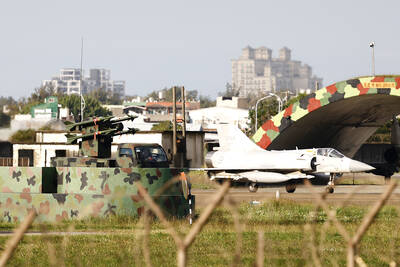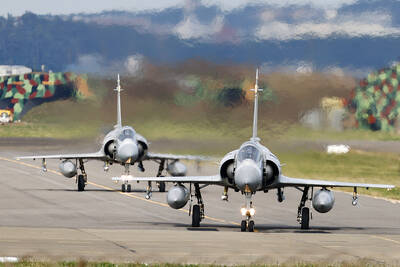The naval officer who was reportedly responsible for firing a missile into the Taiwan Strait by accident on Friday might have done so due to fatigue, the Ministry of National Defense said yesterday, adding that the missile launch control procedure would be revised so that a device necessary to activate the launch sequence would be held in the safekeeping of warship commanders.
According to the Kaohsiung District Prosecutors’ Office, second-class petty officer Kao Chia-chun (高嘉駿) was sleep-deprived when he accidentally launched a Hsiung Feng III missile on a Chinchiang-class corvette. The missile ripped through a Taiwanese fishing vessel, killing the boat’s captain and injuring three crew.
Kao allegedly had a sleepless night due to stress prior to an equipment inspection and test on Friday, and during a rehearsal of the missile-launch procedure ahead of the test, Kao accidentally switched the missile control panel into “battle mode” and touched the “launch” button, thereby setting off a supersonic anti-ship missile armed with a live warhead.
Chief petty officer Chen Ming-hsiu (陳銘修) accompanied Kao to the operations room to rehearse the drill, but he later went out for a break, leaving Kao alone in the room.
Chen rushed back to the operations room and shifted the control panel back to “training mode” immediately after hearing the missile launch, but he was unable to terminate the missile launch or destroy it.
Prosecutors said Kao had been operating the missile launch system for three years and it was unimaginable that an experienced officer could commit such an error.
Further investigations would be conducted to determine whether the missile was launched by mistake or on purpose and the two men are to be charged with professional negligence causing death, prosecutors said.
To prevent accidental missile launches, the ministry yesterday said that it would require the commanding officer of a battleship to keep a device necessary to launch a missile in their safekeeping.
The device is a plug that connects a wire used to send a launch order, and it has until now been kept by the weapons systems officer, but the ministry said the piece of equipment would now be transferred to the commanding officer of a warship.
The order extends to all the navy’s combat vessels, including Kidd-class warships, Cheng Kung-class, Kang Ding-class and Chi Yang-class frigates, Chinchiang-class corvettes and missile patrol boats.
Navy Command Headquarters Chief of Staff Vice Admiral Mei Chia-shu (梅家樹) said the launch plug was deployed in the misfire incident last week.
The plug is deployed not just during war games, but during regular inspections, even if no missile is scheduled to be launched, Mei said.
Asked whether the control system could be redesigned to prevent accidental launches by a single officer, Mei said the weapons system is designed to be engaged immediately in the event of a war, adding that the navies of all countries deploy a two-person control mechanism to validate a launch order.

Taiwan is gearing up to celebrate the New Year at events across the country, headlined by the annual countdown and Taipei 101 fireworks display at midnight. Many of the events are to be livesteamed online. See below for lineups and links: Taipei Taipei’s New Year’s Party 2026 is to begin at 7pm and run until 1am, with the theme “Sailing to the Future.” South Korean girl group KARA is headlining the concert at Taipei City Hall Plaza, with additional performances by Amber An (安心亞), Nick Chou (周湯豪), hip-hop trio Nine One One (玖壹壹), Bii (畢書盡), girl group Genblue (幻藍小熊) and more. The festivities are to

Auckland rang in 2026 with a downtown fireworks display launched from New Zealand’s tallest structure, Sky Tower, making it the first major city to greet the new year at a celebration dampened by rain, while crowds in Taipei braved the elements to watch Taipei 101’s display. South Pacific countries are the first to bid farewell to 2025. Clocks struck midnight in Auckland, with a population of 1.7 million, 18 hours before the famous ball was to drop in New York’s Times Square. The five-minute display involved 3,500 fireworks launched from the 240m Sky Tower. Smaller community events were canceled across New Zealand’s

‘IRRESPONSIBLE’: Beijing’s constant disruption of the ‘status quo’ in the Taiwan Strait has damaged peace, stability and security in the Indo-Pacific region, MOFA said The Presidential Office yesterday condemned China’s launch of another military drill around Taiwan, saying such actions are a “unilateral provocation” that destabilizes regional peace and stability. China should immediately stop the irresponsible and provocative actions, Presidential Office spokeswoman Karen Kuo (郭雅慧) said, after the Chinese People’s Liberation Army (PLA) yesterday announced the start of a new round of joint exercises around Taiwan by the army, navy and air force, which it said were approaching “from different directions.” Code-named “Justice Mission 2025,” the exercises would be conducted in the Taiwan Strait and in areas north, southwest, southeast and east of Taiwan

UNDER WAY: The contract for advanced sensor systems would be fulfilled in Florida, and is expected to be completed by June 2031, the Pentagon said Lockheed Martin has been given a contract involving foreign military sales to Taiwan to meet what Washington calls “an urgent operational need” of Taiwan’s air force, the Pentagon said on Wednesday. The contract has a ceiling value of US$328.5 million, with US$157.3 million in foreign military sales funds obligated at the time of award, the Pentagon said in a statement. “This contract provides for the procurement and delivery of 55 Infrared Search and Track Legion Enhanced Sensor Pods, processors, pod containers and processor containers required to meet the urgent operational need of the Taiwan air force,” it said. The contract’s work would be